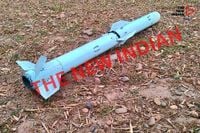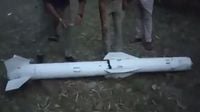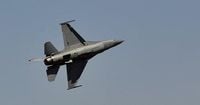NEW DELHI: A fully intact Chinese-made PL-15 long-range air-to-air missile was recovered in Punjab's Hoshiarpur on Friday, May 9, 2025, a day after Indian air defense systems successfully intercepted all missiles and drones fired by Pakistan. Reports indicate that the missile was likely launched from a Pakistan Air Force (PAF) jet, most probably a JF-17, but it failed to detonate upon landing.
The missile's recovery marks a significant moment in the ongoing tensions between India and Pakistan, particularly given the advanced technology of the PL-15, which is designed to target aircraft from distances of approximately 200 to 300 kilometers. The missile features an active radar homing guidance system and is equipped with a two-way data link, allowing it to receive updates from various platforms, including AWACS aircraft.
Amit Malviya, chief of the BJP's IT cell, confirmed the missile's intact condition on social media, stating, "A fully intact Chinese PL-15 long-range air-to-air missile was recovered in Hoshiarpur, Punjab—clearly launched from a PAF jet, most likely a JF-17. It failed to detonate." This incident could provide India with valuable intelligence, enabling defense scientists to analyze the missile's systems, which may lead to advancements in India's indigenous missile technology.
Experts believe that studying the PL-15 could help India enhance its own beyond-visual-range (BVR) missile programs, such as the Astra Mk-2 or Mk-3. Moreover, understanding the missile's capabilities and vulnerabilities could allow Indian forces to refine their tactics and improve the effectiveness of their air defense systems, including the S-400 systems currently operational along India's borders.
On the night of May 8, Pakistan launched missile strikes targeting military installations across border states in India, including Jammu and Kashmir, Punjab, Rajasthan, and Gujarat. However, all missiles were intercepted or neutralized by Indian defenses, showcasing the effectiveness of India's aerial shield, which includes the Integrated Counter-Unmanned Aerial System (UAS) Grid, S-400 Triumf systems, and other advanced missile technologies.
In a related operation, the Indian armed forces executed 'Operation Sindoor' on May 7, targeting nine terror camps in Pakistan and Pakistan-occupied Kashmir (PoK). This military action was a direct response to a recent terror attack in Pahalgam that claimed the lives of 26 civilians, including a Nepalese citizen. JeM chief Maulana Masood Azhar acknowledged losses within his ranks due to India's strikes.
As tensions escalated, the Border Security Force (BSF) also successfully neutralized a major infiltration attempt backed by Pakistani forces in Jammu’s Samba sector on the night of May 8-9. Alert BSF troops engaged infiltrators, reportedly killing at least seven terrorists and destroying a Pakistani Rangers’ post in Dhandhar.
India's air defense capabilities have been significantly upgraded since 2014, with a Rs 35,000 crore deal signed in 2018 for five S-400 Triumf squadrons, three of which are now operational. This strategic enhancement aims to counter threats from both Pakistan and China, reinforcing India's military readiness.
The recovery of the PL-15 missile is seen as a double-edged sword; while it presents an opportunity for India to gather intelligence on Chinese military technology, it also raises questions about the reliability of Pakistan's advanced weaponry. Defense experts suggest that the failure of the PL-15 during its launch could be an embarrassment for both China and Pakistan, given its reputation as a cutting-edge missile.
In another development, reports emerged of a Pakistani F-16 pilot being taken into custody after an Indian Surface-to-Air Missile (SAM) system shot down the fighter jet, which had taken off from Pakistan's Sargodha Air Base. There are also unconfirmed reports regarding the downing of a JF-17 during the ongoing military operations.
The Indian Ministry of Defence stated that all threats from Pakistan were swiftly neutralized, with no casualties or material losses reported on the Indian side. This response underscores India's commitment to defending its sovereignty and ensuring the safety of its citizens amid rising tensions.
As the situation continues to unfold, Indian security agencies remain vigilant, with further investigations into both the missile recovery and the infiltration attempts. The government is expected to respond decisively to these provocations in the coming days, reinforcing its stance against cross-border terrorism.
In summary, the recovery of the PL-15 missile and the recent military actions highlight the complex and volatile nature of India-Pakistan relations. With both nations on high alert and engaged in military posturing, the potential for further escalation remains a concern for regional stability.



